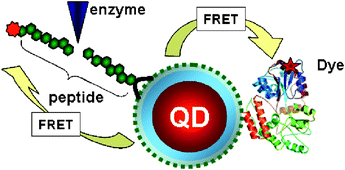Quantum dot-based resonance energy transfer and its growing application in biology
Abstract
We provide an overview of the progress made in the past few years in investigating

* Corresponding authors
a
U.S. Naval Research Laboratory, Center for Bio/Molecular Science and Engineering, Code 6910, and Division of Optical Sciences, Code 5611, 4555 Overlook Ave, S.W. Washington D.C., USA
E-mail:
hedi.mattoussi@nrl.navy.mil
We provide an overview of the progress made in the past few years in investigating

 Please wait while we load your content...
Something went wrong. Try again?
Please wait while we load your content...
Something went wrong. Try again?
I. L. Medintz and H. Mattoussi, Phys. Chem. Chem. Phys., 2009, 11, 17 DOI: 10.1039/B813919A
To request permission to reproduce material from this article, please go to the Copyright Clearance Center request page.
If you are an author contributing to an RSC publication, you do not need to request permission provided correct acknowledgement is given.
If you are the author of this article, you do not need to request permission to reproduce figures and diagrams provided correct acknowledgement is given. If you want to reproduce the whole article in a third-party publication (excluding your thesis/dissertation for which permission is not required) please go to the Copyright Clearance Center request page.
Read more about how to correctly acknowledge RSC content.
 Fetching data from CrossRef.
Fetching data from CrossRef.
This may take some time to load.
Loading related content
